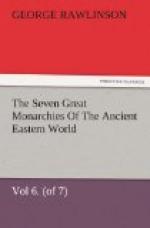The year, A.D. 116, seems to have closed with this memorable failure. In the following spring, Chosroes, learning the retreat of the Romans, returned to Ctesiphqn, expelled Parthamaspates, who retired into Roman territory, and re-established his authority in Susiana and Southern Mesopotamia. The Romans, however, still held Assyria (Adiabene) and Upper Mesopotamia, as well as Armenia, and had the strength of the Empire been exerted to maintain these possessions, they might have continued in all probability to be Roman provinces, despite any efforts that Parthia could have made to recover them. But in August, A.D. 117, Trajan died; and his successor, Hadrian, was deeply impressed with the opinion that Trajan’s conquests had been impolitic, and that it was unsafe for Rome to attempt under the circumstances of the time any extension of the Eastern frontier. The first act of Hadrian was to relinquish the three provinces which Trajan’s Parthian war had added to the Empire, and to withdraw the legions within the Euphrates. Assyria and Mesopotamia were at once reoccupied by the Parthians. Armenia appears to have been made over by Hadrian to Parthamaspates, and to have thus returned to its former condition of a semi-independent kingdom, leaning alternately on Rome and Parthia. It has been asserted that Osrhoene was placed likewise upon the same footing; but the numismatic evidence adduced in favor of this view is weak; and upon the whole it appears most probable that, like the other Mesopotamian countries, Osrhoene again fell under the dominion of the Arsacidae. Rome therefore gained nothing by the great exertions which she had made, unless it were a partial recovery of her lost influence in Armenia, and a knowledge of the growing weakness of her Eastern rival—a knowledge which, though it produced no immediate fruit, was of importance, and was borne in mind when, after another half-century of peace, the relations of the two empires became once more unsatisfactory.
The voluntary withdrawal of Hadrian from Assyria and Mesopotamia placed him on amicable terms with Parthia during the whole of his reign. Chosroes and his successor could not but feel themselves under obligations to the monarch who, without being forced to it by a defeat, had restored to Parthia the most valuable of her provinces. On one occasion alone do we hear of any, even threatened, interruption of the friendly relations subsisting between the two powers; and then the misunderstanding, whatever it may have been, was easily rectified and peace maintained. Hadrian, in A.D. 122, had an interview with Chosroes on his eastern frontier, and by personal explanations and assurances averted, we are told, an impending outbreak. Not long afterwards (A.D. 130, probably) he returned to Chosroes the daughter who had been captured by Trajan, and at the same time promised the restoration of the golden throne, on which the Parthians appear to have set a special value.




